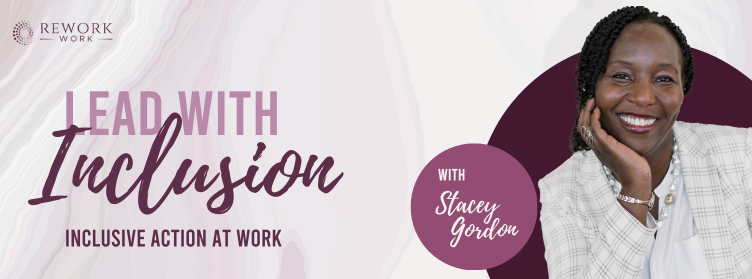
How to welcome “undisclosed” identities at work
Welcome to Lead With Inclusion! This weekly newsletter is a resource for EVERY professional. Whether you’re a manager ready to be a more inclusive leader, or an employee ready to be a DEI champion in your workplace, inclusive actions lead to inclusive outcomes. Leading with inclusion simply means starting with inclusive actions in everything you do. It means identifying the areas where bias is at work, and shifting mindsets to make change.
If you’re not sure where to begin, start here.
One moment that’s stuck with me is when a gentleman from HR said this during a session I facilitated:
“We don’t pay enough attention to neurological conditions and mental illness in the workplace,” he said. “So many people come to me about their depression and their fear that they can’t tell anyone because of the stigma.”
Can you relate? Whether due to a mental health condition, chronic illness, or neurodiversity, a lot of professionals have “invisible” identities that impact how they experience the workplace. Unfortunately, many of these identities are stigmatized, leaving people to make this uncomfortable calculation:
Is it worth being myself at work and speaking candidly about what I’m dealing with? What if I get labeled “the depressed employee” or passed over as someone who can’t cope when stretch assignments or leadership opportunities arise?
Be an Inclusive Leader:
My initial reaction to the comment in my session showed me my own bias towards visible identities: afterall, I’m a Black woman and I don’t have a choice about whether to keep those identities private.
Some identities are usually visible—race, gender identity, (some) disabilities, age. Others are visible less often, and leave the burden on the individual whether to disclose them: neurological differences, sexual orientation, (some) disabilities, mental wellness, religion, chronic illness, and more.
All kinds of diversity deserve respect and recognition.
My knee-jerk reaction made me realize that I was missing out on a unifying aspect of the human experience: No matter how you identify, it feels bad when something about you is ignored, belittled, mocked, overlooked, or stigmatized. It feels bad when you don’t have the psychological safety to bring your full self to your job or relationships.
This is a reminder that we ALL have bias, and it’s important that we be respectful and inclusive of ALL people—including those whose identities aren’t obvious to us.
Lead with Inclusion:
The uncomfortable truth is that when someone’s marginalized identity isn’t visible, it’s easy for us to ignore it. That’s not because we don’t care, but because we’re all biased toward our own experience of the world. If your experience hasn’t included, say, long Covid or clinical anxiety, you’re unlikely to consider what people with those experiences need at work to thrive.
That’s why mindful self-awareness and self-education are key to being inclusive of and welcoming to all identities and experiences in the workplace.
Here are concrete ways you can expand your awareness and education, and take action within your company:
Consider how your company’s policies could accommodate diverse working needs: do you offer flex time? What about personal leave for any reason (as opposed to specific caregiving leave or sick time)?
When recruiting, post flexible jobs to job sites dedicated to people with less visible marginalized identities, like Chronically Capable.
Know that people who experience mental health conditions or chronic illness may not feel safe disclosing those personal details at work. It’s never appropriate to confront or call out someone at work (or gossip about them behind their back).
Subscribe to a podcast by and for an audience with a less visible identity. Here’s one from my friend Shannah.
Recognize the need to learn more about dimensions of diversity you're less familiar with
Make the time and effort to connect with team members you don’t know, with openness and curiosity
I’d love to hear what your company has done to include less visible forms of diversity. What changes has leadership made to be accommodating? What resources are available? Have you seen a good example at work of this kind of inclusion and support? Do share in the comments.
About Stacey Gordon:
Stacey Gordon is Executive Advisor and Founder of Rework Work where she and her team coach and counsel executive leaders on DEI strategies for the business, while offering a no-nonsense approach to unconscious bias education for the broader employee population. As a global keynote speaker, Stacey is a Top Voice on LinkedIn and a popular LinkedIn Learning [IN]structor with nearly two million unique learners enjoying her courses.
Want to hear Stacey live? Consider booking her for your next keynote or workshop.
RGICL,CGICL,FGICL,SGICL,BAGICL,SBI,MGICL,ACKO,RQGICL,KMGICL,,EGICL, OF GIC,OSRTC, L&T,CHOLA ,SHRIRAM,TATA,BFCL ,SUNDARAM FINANCE LTD and Arbitrator.
2wSEEN
I help companies create more inclusive and diverse workplaces 🤝 Making DEI simpler, efficient, and measurable 📈 Co-Founder @ Élance - where data meets inclusion
2wIt's eye-opening to see the emphasis on "undisclosed" identities and the need for better understanding and inclusion.
ATS Friendly Resumes || Tech Resume writing || Federal Resume Writing || Content Creator || Article Writing || HR Manager.
2wAn inclusive environment is key to success in modern workplaces. Diverse identities can be bound in a single thread by Inclusiveness.
Leadership Coach and Consultant | Speaker | Trainer | Strengths-Based Leadership | Mastermind Facilitator | I empower women leaders to BE more by doing LESS!
2wThank you for this insightful article Stacey...as leaders, we must create a safe space for safety and trust to flourish.
Human Resource Professional | MBA | Coporate Recruiting Professional- ASA | Ex-Wirtgen Group,A John Deere Company
2wI appreciate the perspective shared here. Thank you for sharing this. I believe integrating mental health support into existing employee assistance programs or training managers to recognize and respond to signs of distress in their teams will also be very helpful. Educating ourselves and fostering open communication are key steps towards creating a truly inclusive workplace culture for less visible identities.